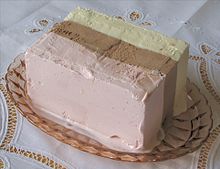Neapolitan ice cream

Block of Neapolitan ice cream
|
|
| Alternative names | Harlequin ice cream |
|---|---|
| Place of origin | Italy |
| Main ingredients | Vanilla, chocolate, and strawberry ice cream |
| Variations | Historically, colours were of the Italian flag: green (pistachio or almond), white (vanilla), and red (cherry, actually pink) |
| |
|
Neapolitan ice cream, sometimes known as harlequin ice cream, is a flavor of ice cream made up of three separate flavored blocks of vanilla, chocolate, and strawberry ice cream side by side in the same container (typically with no packaging in between). Some brands intermix the flavors more, though the separate flavors are still clearly visible.
In Ireland, HB, the most popular brand, uses Vanilla, Strawberry and Lemon flavour ice creams.
Neapolitan ice cream was named in the late 19th century as a reflection of its presumed origins in the cuisine of the Italian city of Naples, and the many Neapolitan immigrants who brought their expertise in frozen desserts with them to the United States. Spumoni was introduced to the United States in the 1870s as Neapolitan-style ice cream. Early recipes used a variety of flavors; however, the number of three molded together was a common denominator, to resemble the Italian flag (cf. ). More than likely, chocolate, vanilla, and strawberry became the standard for the reason that they were the most popular flavors in the United States at the time of introduction.
The first recorded recipe was created by head chef of the royal Prussian household Louis Ferdinand Jungius in 1839, who dedicated the recipe to Fürst Pückler.
"Cosmopolitan slice. A slice of ice-cream cake made with mousse mixture and ordinary ice cream, presented in a small pleated paper case. Neapolitan ice cream consists of three layers, each of a different colour and flavour (chocolate, strawberry, and vanilla), moulded into a block and cut into slices. Neapolitan ice-cream makers were famous in Paris at the beginning of the 19th century, especially Tortoni, creator of numerous ice-cream cakes."
"Eighteenth century... confectioners' shops [were] very often run by Italians. Consequently ice creams were often called "Italian ice creams" or "Neapolitan ice creams" throughout the nineteenth century, and the purveying of such confections became associated with Italian immigrants."
...
Wikipedia
